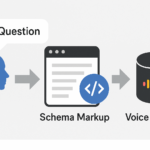Conversational Content Strategy: Write for How People Talk, Not Type

AEO vs SEO – Understanding the Difference and Why Both Matter
July 9, 2025
Conversational Search Schema – Boost Visibility with Structured Data
July 9, 2025Why Conversational Content Matters
Have you ever asked your phone, “Where can I get my furnace repaired today?”
Or typed into Google, “good local HVAC?”
The way people speak and the way they type are two different things. And if your website content doesn’t reflect how real people ask questions out loud, you could be missing out on search visibility.
Welcome to the world of conversational content strategy—a way of writing that mirrors natural human speech so your brand sounds approachable, relevant, and most importantly, findable.
What Is Conversational Content?
Conversational content is written the way people talk—not the way we used to write for search engines. It's direct, friendly, and structured to answer real-world questions clearly and quickly.
This means:
- Short, natural sentences
- Common words over technical jargon
- Real questions, not just keywords
- Tone that feels like a conversation, not a textbook
This kind of content is easier for both people and AI tools to understand—and it’s exactly what powers voice search and featured snippets.
Why This Strategy Works
- It aligns with how people search. Voice search, AI chat tools like ChatGPT, and Google’s SGE all rely on natural language to find and present answers.
- It increases engagement. Visitors stay longer when content feels like it’s written for them, not a robot.
- It builds trust. A warm, human tone makes your brand more relatable and helpful.
5 Keys to Writing Conversational Content
1. Answer Real Questions
Think about what your customers are actually asking—then write content that answers it clearly.
Examples:
- “How much does a tankless water heater cost?”
- “What should I do if my basement floods?”
- “Is it better to lease or finance a vehicle?”
2. Use Everyday Language
Avoid industry jargon or overly formal writing. Instead of saying:
Our solutions facilitate seamless integration of digital platforms...
Say:
We help your tech tools talk to each other so everything works better.
If you wouldn’t say it out loud to a customer, rewrite it.
3. Keep Sentences Short
People don’t talk in long, complex sentences—and they won’t read them either. Aim for clarity over cleverness.
4. Use “You” and “We”
Speak directly to the reader:
- “You’ll save time with this process.”
- “We’ll help you set it up in a few steps.”
It feels more personal and creates connection.
5. Format for Easy Reading
Even the best writing gets skimmed. Help your audience (and Google) with:
- Clear headings
- Bullet points
- Bolded key phrases
- Short paragraphs (2–3 lines max)
Examples of Conversational vs. Formal Content
| Formal Web Copy | Conversational Rewrite |
|---|---|
| Our firm provides accounting solutions to streamline your operational efficiency. | We help you simplify your accounting so it’s faster and easier to manage. |
| Users must input login credentials to access the secure dashboard. | Just log in with your email and password to see your dashboard. |
| We facilitate best-in-class SEO services for growing businesses. | We help businesses like yours get found on Google. |
Where to Use Conversational Content
- Service pages: Speak to the reader directly about their needs
- FAQs: Write like you’re replying to a customer in real life
- Blog posts: Start with a question, then answer it
- Email sequences: Keep it friendly, like a real conversation
- Chatbots and voice interfaces: Match the tone of the interaction
How It Supports SEO & AEO
Conversational content isn’t just nice to read—it’s functional.
- Helps you rank in “people also ask” and featured snippets
- Boosts visibility in voice search results
- Powers AI chat tools that rely on clean, understandable content
- Improves time on page, bounce rates, and conversions
The more natural and helpful your content is, the more likely it is to show up when someone searches for answers.
Ready to Sound Like a Human (and Get Found by AI)?
At Hyperweb, we help businesses shift their web content from robotic to real. Whether it’s rewriting service pages, building FAQ banks, or optimizing for voice and AI, we’ll help you speak the language your customers use.
Want to see how your content measures up?
Contact us for a conversational content audit
Explore More on This Topic
- Voice Search Optimization – Make your content easy to find (and hear)
- Conversational Search & AI Optimization – Understand the bigger shift in how people search
- Schema for Conversational Search – Boost visibility with structured data
<– Check out this photo of Carl. That’s carl when he was doing Ironman races. Trust me – he doesn’t look like that anymore. 🙂 But he’s still opinionated as ever. Hopefully, you liked his writing.
